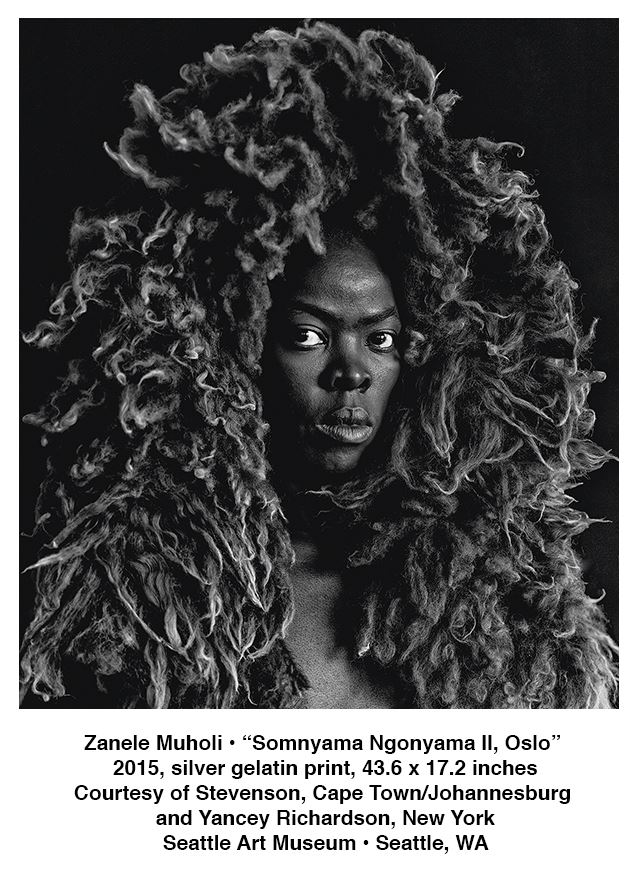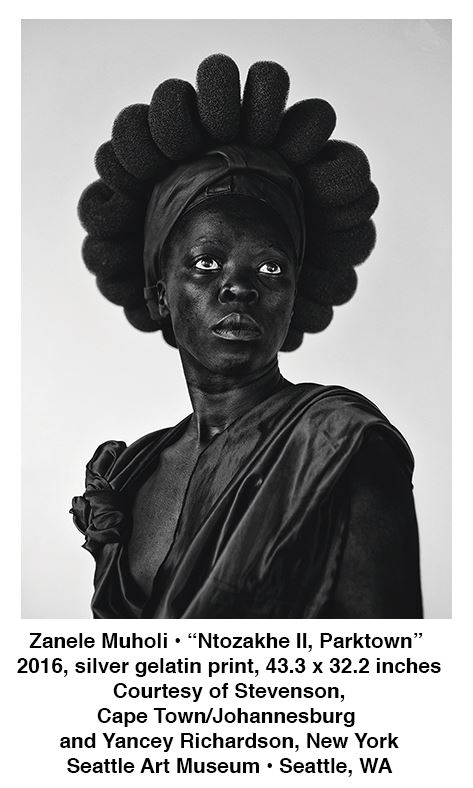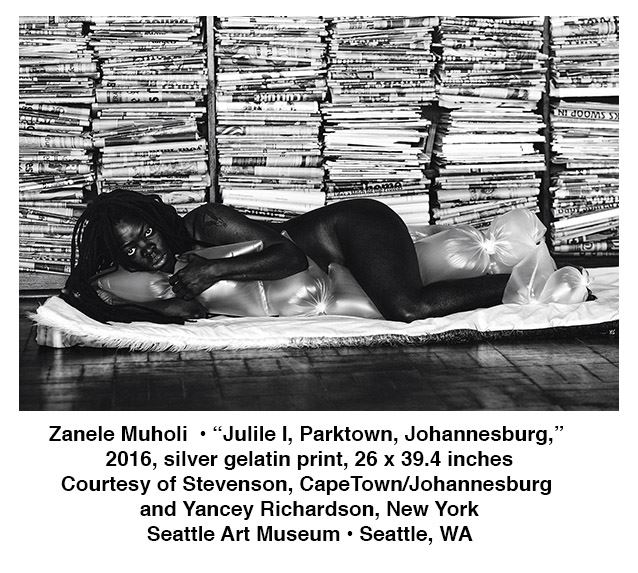 From three galleries away the huge self portrait photograph of Zanele Muholi dominates the view. The mesmerizing image called “Somnyama Ngonyama: Hail the Dark Lioness,” gazes at us in a side wise glance. The giant mane of hair, a headdress of sheepskin, cascades and almost buries the small face. Keeping in mind that it is the male lion that has a mane, this lioness identifies as they. Their expression is hard to decipher. While the scale of the work suggests domination, the face is self contained and private.
From three galleries away the huge self portrait photograph of Zanele Muholi dominates the view. The mesmerizing image called “Somnyama Ngonyama: Hail the Dark Lioness,” gazes at us in a side wise glance. The giant mane of hair, a headdress of sheepskin, cascades and almost buries the small face. Keeping in mind that it is the male lion that has a mane, this lioness identifies as they. Their expression is hard to decipher. While the scale of the work suggests domination, the face is self contained and private.
 This title image by South African artist Zanele Muholi prepares us for what is to come. Every single photograph is a self portrait, with the artist gazing fixedly and inescapably, sometimes directly at us. Opposite the “Lioness,” a mural sized reclining Muholi clutches plastic pillows against a background of stacks of newspapers. They are unavailable, gazing beyond us. Reclining Venus they are not. At the end of the adjacent hall, a “Statue of Liberty” Muholi, wearing a crown of foam loops, gazes skyward.
This title image by South African artist Zanele Muholi prepares us for what is to come. Every single photograph is a self portrait, with the artist gazing fixedly and inescapably, sometimes directly at us. Opposite the “Lioness,” a mural sized reclining Muholi clutches plastic pillows against a background of stacks of newspapers. They are unavailable, gazing beyond us. Reclining Venus they are not. At the end of the adjacent hall, a “Statue of Liberty” Muholi, wearing a crown of foam loops, gazes skyward.
As we enter the Jacob Lawrence and Gwen Knight Gallery at the Seattle Art Museum, the full force of the gazes of the self portraits strikes us from all four walls. The first wall refers to colonialism, with a huge portrait sporting a (paper) ruff (from the packing for children’s toys) as in the era of Rembrandt and the occupation of Africa. On one long wall we start with plastic pollution, then move to enslavement, and service and exploitation. A few images turn away, some are personal, as in the self portrait honoring her sister, a gentle and proud Muholi wears a crown and necklace of rubber inner tubes that confer majesty. They are defiantly inverting the violent history of rubber in Africa, where the Belgian King Leopold ruthlessly killed thousands to satisfy his thirst for that “natural” product. Rubber appears repeatedly here as a garment, necklace, or headdress.
The props gathered in the street, and thrift stores, drastically alter the effect, transforming the same face from royal to ironic, but never oppressed. Defiance is the common theme. In one work, the artist dons a milk stool on their head, and tangled straw around their neck as a reference to farming. In others they blend into a rocky landscape or deep forest commenting on making visible the invisible black body. As a mask in the midst of African market kitsch the artist gives us the absurdity of tourist capitalism.
Two videos provide background, speaking of the ten year project of documenting the victims of hate crimes against LGBTQIA South Africans,as well as photographing the dignity and beauty of Trans and Lesbians in over 500 portraits. They wanted to celebrate community and create respect.
In 2012, their studio was ransacked and the perpetrator deliberately destroyed the hard drive of current work that had not yet been published or even printed.
It was then that Muholi turned to self portraiture, a painful act of exposure. These portraits are identified by and subtly connected to the location where they were taken, a wide ranging geography. But the artist stood in humble hotel rooms to stage the images.
Each work has a title in isiZulu, and English. Muholi (that word actually means Leader) confronts us with their occupation of our white space on their own terms. We come away with a feeling of uplift, humility, and awe, for their photographic prowess as well as their courage.
Not far away on the same floor is the Betty Bowen award winner Natalie Ball (Modoc, Klamath). Ball is descended from the famous leader of the late nineteenth century Modoc resistance, Captain Jack. That heritage of warrior defiance is obvious here. Ball’s two pieces “You Mist, again (Rattle)” and “Re Run” make up the installation “Twinkle, Twinkle Little Snake.” The title tells you a lot, interrupting the familiar nursery rhyme about the stars with a snake that can be both threatening and magical. The installation is ironically (intentionally?) juxtaposed to a well-known work by Marsden Hartley in the adjacent American Art Gallery which borrows native American designs, a widespread practice in the early twentieth century (and still). In every detail of these complex collaged sculptures, Ball explores the collision of indigenous and white cultures as well as African American, also part of her heritage (note the bullet shells embedded in one of the works). But she is also celebrating indigenous vitality and incorporating trickster humor.
Rattlesnake skin appears as part of both works (although significantly identified simply as rattlesnake), a skin that a snake has shed, after it regrows another, a clear reference to the survival abilities of indigenous peoples, in spite of white man’s best efforts to obliterate them. The diamond patterned quilt suggests joy, but everything is off kilter. The cut up sports jerseys, letters, and logo disrupt any possible cliché of Native or African American culture, giving us instead a proud declaration of survival in the face of extreme pressure.
Susan Noyes Platt
Susan Noyes Platt writes a blog www.artandpoliticsnow.com and for local, national, and international publications.
“Zanele Muholi: Somnayama Ngonyama, Hail the Dark Lioness” is on view through November 3 and “Natalie Ball: Twinkle, Twinkle, Little Snake” is on view through November 17. Both exhibits are at the Seattle Art Museum, located at 1300 First Avenue in Seattle, Washington. Museum hours are Friday through Monday from 10 A.M. to 5 P.M. and Thursday from 10 A.M. to 9 P.M. For information, visit www.seattleartmuseum.org.